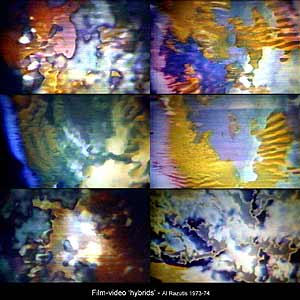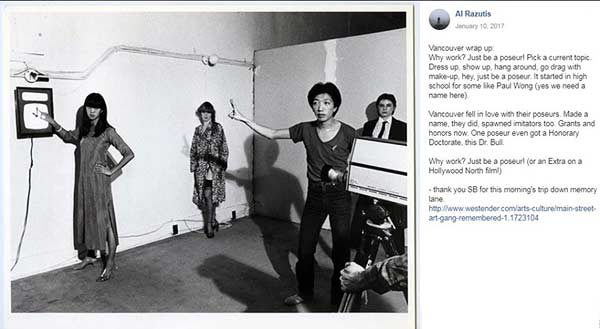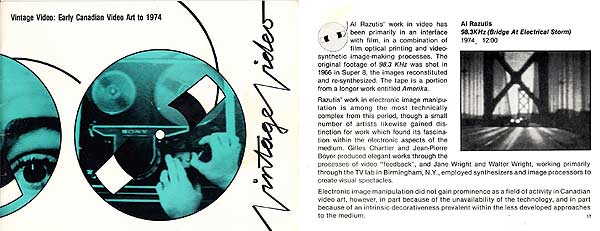'Watercolour Abstract' - the two Video Arts of Canada
Two video cultures -- apparently, acting exclusive of one another

April 11, 2013 at 6:55 AM
I'm in a film archaeology mood again today, in a desert of pasts, in the bushes of ghosts. For how long? It depends on the camels, and how much water there is.
Last night while foraging the tombs, I unearthed a pile of 16mm film prints. There's a purpose to this. Once upon a time film art didn't want video art in the picture, and video didn't want film. Each one called the other names, like 'bad film' or 'bad video'. Strictly apartheid. Each one had an aesthetic 'empire' which it called its own, even though it wasn't built yet. It was like the bronze age, soon to be iron, then not. It was the 'tools', also unearthed, that would give a hint of what it was. Digital would demolish those conceits, once and for all. But remember, we're in the 'analog' era, and hindsight might be '20-20' but reality and time are not dependent on hindsight but on foresight (says an evolutionist).
Open up the vaults, sharpen the memory, write what I can remember, now, not later, and because all things need some confirmation, otherwise they are referred to 'mythology' (a currently popular word in media studies at the U in Vancouver these days, so I read and hear).
The current subject is 'Watercolor/Abtsract', a short video-film poem created in 1973 using both film and video processing as part of something I then called 'hybrids'. (A couple of low-res frame captures included in this post.) These hybrids, which also appeared in three film reels of my later film 'Amerika', featured combinations of film material, video processing (including colorization/keying and feedback, and bio-feedback), and optical printing. These seem to me a direct succession to underground films of the 60's (called 'Synaesthetic films' by Gene Youngblood in his book Expanded Cinema) by SF film-makers like Scott Bartlett, Tom Dewitt, and Jordan Belson (and others), works that I had seen and shown in the 67-69 underground cinemas that I created and ran at UC Davis, and notably Intermedia, Vancouver, second floor, where I was first told that 'nobody would come'. Yes, second floor, a screen of white paper attached to a hanging rug, no seats, a couple of 16mm projectors, and a full house every weekend, and for a buck admission.
Here's a section and on-line descriptions from my film video archives page on some of these 'hybrid' film-videos-film that I made in the 70's:
'Videographics - Film / Video Hybrids'

And these film-video hybrids, along with a 60 minute 1" tape piece that Gary Lee-Nova and I made titled "Hybrid" (in the collection of the Vancouver Art Gallery, but really out of sight of their interests now that the 'Vancouver School' of academic (salon of theory) photography has dominated the town for decades, these hybrids were pretty much unique in Canada at the time. But don't take my word for it, do some digging yourself.
When I refer to 'hybrids' I refer to two image processing - synthesizing technologies and two machines I built for this. Some of us not hung up on 'media purity' welcome all the cross-overs from film to video and video to film and then digital came afterwards. A page dedicated to 'Felix' my video synthesizer of the 70's is at:
'Felix' - First Videosynesizer in Canada

It's clear why this synthesizer was not left with the local performance video mecca 'Western Front' but sold to the 'east' (Walter and Jane Wright teaching in Ontario). It was sent to where it would be appreciated.
And no, the Western Front or the Video In had nothing to do with hybrid works or synaesthetic cinema in Vancouver, and in fact they hated the stuff in the 70's, preferring their own docs on their performances (WF), making political docs (VI), or imitating imported 'resident artists' for future resume gain (on the part of some bull-shitters by name.) But when fashions changed (and synaesthetics became fashionable) these orgs started 'liking this stuff' and presumably got some grants (or at least sat on juries) to make 'some' of that 'history of media' using processes and tools they didn't invent, and certainly appropriated.
('Wow, the sun must be getting hot (you might think)' as this travel documentary into the land of Hybrids gets the narrator saying things that no 'proper academic' would dare utter. Well, like Brad Pitt in '12 Monkeys' (the film by Terry Gilliam), 'screw academia, and screw the government sponsored state culture'. It certainly has screwed us.)
Back to reality and the findings in hand:
For a photo of the essay Gary Lee-Nova and I wrote titled 'Hybrid' that was published in 'ARTSCANADA' special issue on video art in 1973 see this link - it contains the Vancouver section. That issue is a real time-capsule of what was happening in Vancouver video at the time, and not as some Governor General (of Canada) awardees (more bullshitters) might claim:
ARTS CANADA 1973 - 'THE VIDEO ISSUE'

Here's an excerpt from my correspondence with Mark Toscano (Academy Archives, Hollywood) about this film, which he now has at the archives, a film hybrid on 16mm, of which there is no known copy or print except for a can of original printing elements, timing tape for additive model-C printer.
"The process of this experimentation started when I taught at Evergreen State College, Olympia WA, in a free-wheeling media program that they had instituted there in 1970-71. The college was financed as a 'experimental curriculum' with all kinds of media (film, video, early computing, later holography) with all kinds of visiting (and some permanent) faculty artists, and this was my first serious teaching gig. So in the labs we synthesized with film and video..."
This FB post and text, intact or in extracts, is headed for my writings archive page, where it should stay beyond the 22 hour memory limits of face book and timelines all fading into some computer cloud of disconnected pasts, up there in the arctic circle.
Videographics - Synaesthetic and Hybrid Video/Film by Razutis
Intermedia - Synaesthetic Cinema Page - 'films like this'
"The Second Video Art - Performance and Posing
When I refer to 'poseurs' I refer to a genre of performance art and video that privileges posing over anything else, engages the mind in a guessing game of 'what does this mean?, 'what is so profound about this?' This narrative-based work became big time in Vancouver 'video' circles after it was exported there by New York in 1969 to Intermedia, Vancouver. 'Even standing still has a narrative!' intoned the poseurs, and so it came to pass, a 'school' was born.
- photo Michael de Courcy, Intermedia archives.
And then came Video In, followed by Paul's Queer Video Nation. Pose away! Governor General awards too!"

More response and comment below.
"The Critics Respond - against and for Synaesthetic and Hybrid Video Art
The case AGAINST 'synaesthetic video art' was made by curator (and past Canada Council video officer) Renee Baert in her 1974 curator's statement for "Vintage Video: Early Canadian Video Art" exhibition. For example, in the depicted page she writes what would become later (in my view) "Official Canadian Curating Policy for Video Art":
"Electronic image manipulation did not gain prominence as a field of activity in Canadian video art, however, in part because of the unavailability of the technology, and in part because of an intrinsic decorativeness prevalent within the less developed approaches to the medium"
Let me repeat that:
"...intrinsic decorativeness prevalent within the less developed approaches to the medium" is a value judgment which implies that synaesthetic video is both 'decorative' and 'less developed... I hope this bias is CLEAR, and that's what was applied to this form for decades by the Canada Council.

Click to enlarge in separate window
The case FOR film video hybrids and synaesthetic ciname (as in my film "98.3 KHz: Bridge at electrical storm" was made by Bruce Jenkins, Walker Center, in his essay on the exhibition "Magnetic North", and the relevant pages of the article "Film to Video / Video to Film" pertaining to this issue are posted at:
FILM TO VIDEO / VIDEO TO FILM by Bruce Jenkins

Of course the classic 1970 book 'EXPANDED CINEMA' by Gene Youngblood is all about synaesthetic cinema, experimental cinemas of many kinds and requires little introduction. A page on some of thse aspects of synaesthetic cinema is here at Intermedia - Synaesthetic Cinema on this web site.
"What do I care, what do I know
Of course my preferences are clearly towards 'synaesthetic video', performance in bio-feedback, playing video like a musical orchestra, not the posing kind of thing. Is this 'anti-social behavior' to make video art as an experimental media procedure? Is it anti-social to create one's tools from scratch? From my perspecive those who just 'use the media' to 'record events' including their performances (for the camera) represented a different 'culture' of videomakers from us experimentalists who had no trouble crossing over from film to video to film and to performance with experimental technologies.
For example, this kind of 'hybrid' film-video thing has been a signature of mine of that cross over from film to video and back to the big screen again:
98.3 KHz: (Bridge at electrical storm by Al Razutis

In my view, those typically using video and recording performance, recording their theatre, acts, playtime, pets or their vaginas were really using 'whatever recording means was at hand', using the language of 'film', using video as a 'matter of convenience' (it was a cheap medium compared to film!). Many of these performance artists hired others to produce their work, do their shooting /editing for them; many designed nothing but played with or for an audience in a theatre of 'video art' which resembled the 'commercial video thing', down to the 'Betacams' they got with their funding. To me this work is related to the selfie generation of viral smartphone videos, and really, 'where is the video art thing now... but everywhere?' It's advantage seemed to be that it can be sold to a jury of 'grant givers', because after all the explanation was the narrative and the 'art thing'.
Historically, starting with the 1970's it was the performance artists and poseurs who won control of the Canadian cultural agenda, then tied it in with minimalism and structuralism (of the kind Michael Snow made). They ended controlling video arts grant juries right up to this year, 2020. I know from personal experience, and now nearly 25 years of grant application to Canada Council and BC Arts Council later, with nothing but rejections, I know who is in vogue and which 'house of the word' we are in."
-- commentary by Al Razutis 2013-2020
As posted in part on FaceBook Visual Alchemy studio page
[FILMS AND VIDEOS] [3D VIDEO] [HOLOGRAPHY]

